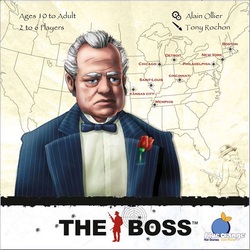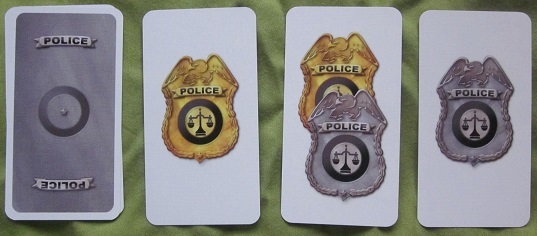The Boss
 In the board game
The Boss
, the game is divided into several rounds. The ending condition is determined in a unique manner, as follows. The game includes five police cards:
In the board game
The Boss
, the game is divided into several rounds. The ending condition is determined in a unique manner, as follows. The game includes five police cards:
- two cards have one gold badge on them,
- two cards have one silver badge on them, and
- one card has both gold and silver badges on them.

At the beginning of the game, all five cards are shuffled and set face down. In each round, one police card will be opened; if there are three badges of the same color, this indicates that the game ends after the current round is finished.
Determine the expected number of rounds played in the game.
The answer is 4.0.
This section requires Javascript.
You are seeing this because something didn't load right. We suggest you, (a) try
refreshing the page, (b) enabling javascript if it is disabled on your browser and,
finally, (c)
loading the
non-javascript version of this page
. We're sorry about the hassle.
Instead of opening one randomly after each round, let's simply set the order of all of them at the beginning but only opening them one by one; this doesn't change the probabilities (since we don't know what are the cards that are still closed).
First, observe that the game cannot last less than three rounds or more than five rounds: each card only has one badge of any color, so to get three badges of the same color, we need at least three rounds, but opening all five cards will guarantee the existence of three badges of a color (in fact of both colors), so the game will not last more than five rounds.
Now, in order for the game to last for five rounds, the double-badge card must be opened last. If the double-badge card is opened at any other time, after four rounds there will be five badges opened (the double-badge card must have been opened if it's not last), and by Pigeonhole Principle there are three badges of the same color, ending the game without going to the fifth round. However, if the double-badge card is opened last, it's impossible for the game to end before the fifth round; there are only two badges of each color in the first four rounds. Thus, the probability of the game ending after five rounds is simply 5 1 , the probability of getting the double-badge card last.
In order for the game to last for three rounds, the last two cards must be single-badge cards of the same color. Since each color appears in exactly three of the cards, if both of them exist in the last two cards, the game cannot end after only three rounds. Thus there can be only one color in the remaining two cards. In particular, the double-badge card cannot be among any of them. The probability is 5 4 , for getting a single-badge card at the last place, times 4 1 , for getting the other single-badge card of the same color at the second-last place. This gives 5 1 probability to end in three rounds.
By complement of probability, the probability that the game ends in four rounds is thus 1 − 5 1 − 5 1 = 5 3 .
Computing the expectation is now trivial:
E [ rounds ] = 3 ⋅ 5 1 + 4 ⋅ 5 3 + 5 ⋅ 5 1 = 5 3 + 1 2 + 5 = 4